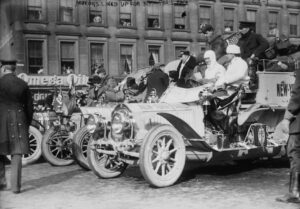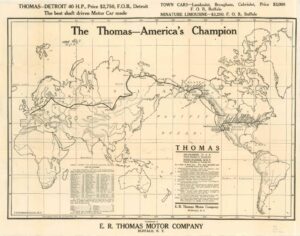
 A car race is most often run on a track, with lots of fans cheering everyone on, but in 1908, there was a very strange car race that actually used a track that took the drivers around the world!! How…you might ask?? Well, the car race started in New York City. From there the route took the racers to San Francisco. Normally, San Francisco would be the end of the trail…or the route. You would have reached the Pacific Ocean, and as we all know, cars can’t drive on the ocean…especially cars manufactured in 1908. So, the racers turned to the north and headed for Valdez, Alaska. They would arrive in Valdez in the height of winter…at a time when the Bering Strait was frozen over…theoretically. At that point there was supposed to be an ice bridge across the Bering Strait, making it possible for the cars to drive right over it and into Russia. Once across, the racers would continue on from Russia to Europe and the finish line awaiting them in Paris. It’s amazing to me to think about cars being driven around the world, but of course the Bering Strait in the Winter, supposedly changed everything. In 1908, cars were relatively new, so road infrastructure was limited to only metropolitan areas, and even then, a lot of it was cobbled stone. So, I suppose cross country car travel on dirt trails was not that uncommon.
A car race is most often run on a track, with lots of fans cheering everyone on, but in 1908, there was a very strange car race that actually used a track that took the drivers around the world!! How…you might ask?? Well, the car race started in New York City. From there the route took the racers to San Francisco. Normally, San Francisco would be the end of the trail…or the route. You would have reached the Pacific Ocean, and as we all know, cars can’t drive on the ocean…especially cars manufactured in 1908. So, the racers turned to the north and headed for Valdez, Alaska. They would arrive in Valdez in the height of winter…at a time when the Bering Strait was frozen over…theoretically. At that point there was supposed to be an ice bridge across the Bering Strait, making it possible for the cars to drive right over it and into Russia. Once across, the racers would continue on from Russia to Europe and the finish line awaiting them in Paris. It’s amazing to me to think about cars being driven around the world, but of course the Bering Strait in the Winter, supposedly changed everything. In 1908, cars were relatively new, so road infrastructure was limited to only metropolitan areas, and even then, a lot of it was cobbled stone. So, I suppose cross country car travel on dirt trails was not that uncommon.
The Great Race of 1908 began on February 3rd of that year and immediately ran into challenges. Just to list a few…cars breaking down multiple times, lack of usable roads, car-hating people giving wrong directions, and, oh yeah, SNOW!!! Nevertheless, the teams persevered, and the first team reached San Francisco in 41 days. The came the obstacle of the fact that the proposed route from San Francisco to Alaska did not exist. I guess that they didn’t think it would be feasible to create the route, so the race organizers allowed teams to ship their cars to Valdez, Alaska, then continue on the Ice Bridge. Some might have called that a bit of a cheat, but I guess if all the racers id it, it wasn’t really cheating. Once in Valdez, the teams found out that there is, in fact, no ice bridge across the Bering Strait anymore, because it melted about 20,000 YEARS AGO. Oops…small oversight. So, the racers were allowed to ship their cars across the Pacific to Japan, then Russia, to carry on. Ok, if you’re like me, at this point, you are starting to see that this race had a lot of flaws in the planning. And honestly, while I knew there was no ice bridge on the Bering Strait today, I was unaware that it melted that long ago…meaning there was not an ice bridge since the “Ice Age!!”
So, was this really a car race around the world or a whole lot of non-sense. To be sure, the six teams did end up in Paris after the race, and they drove all of the route that could be driven, but the reality is that much of the race was simply cars being transported by ships across the ocean. Nevertheless, the “official” race was documented as just that…a car race that went around the world. The cars had to fight mud, snow, and mechanical problems. It was “officially” won by The Thomas Flyer, built by the Thomas Motor Company, was a 1907 Model 35 with a 4-cylinder, 60-horsepower engine capable of reaching 60 mph. It was fully loaded with two shovels, two picks, two lanterns, eight searchlights, two extra gas tanks (with a capacity of ten gallons), five hundred feet of rope, a rifle and revolvers. It was also equipped with an attachable top…much like those used on covered wagons…that could wrap the entire car and offer an enclosed place to sleep. On July 30, after 169 days of travel, the Thomas car entered Paris. Even in Paris, they almost didn’t finish, because a police 
 officer stopped the vehicle, saying it had no working headlight, and couldn’t proceed. A passing bicyclist witnessed the scene and offered to load his bike into the car. Since the bicycle had a working headlight, the officer allowed them to pass. The Thomas Flyer finally finished at 6:00pm. The race was the only “official” car race around the world.
officer stopped the vehicle, saying it had no working headlight, and couldn’t proceed. A passing bicyclist witnessed the scene and offered to load his bike into the car. Since the bicycle had a working headlight, the officer allowed them to pass. The Thomas Flyer finally finished at 6:00pm. The race was the only “official” car race around the world.


Leave a Reply